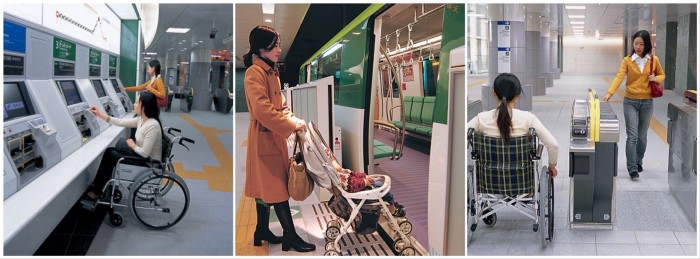As the glossary in my last blog entry shows very well, there are already existing concepts which cover topics that I planned to bring in the context of UX and its establishment during my research. So, in upcoming blog entries, I’ll take a closer look at the following terms: Universal Design, Inclusive Design, Accessibility, Green UX, UX Metrics and everything I’ll come across within this research that turns out to be central for my research topic.
This Blog entry will cover universal design, its 7 principles and its (socio-) ecological impact.
“The power of the Web is in its universality. Access by everyone regardless of disability is an essential aspect.“
— Tim Berners-Lee
Universal Design has its origins in architecture and it is seen variously as a design approach, a process, a paradigm, or as a design attitude leading to a design strategy. This strategy overall aims to create environments that can be used by everyone to the greatest extent possible. Universal design is based on the idea that a design which meets the needs of excluded groups, such as the elderly, children or persons with disabilities, will also improve the product experience of a broad range of social groups.
While universal design is often mentioned along with related concepts like accessibility and inclusive design, it can be distinguished by its goal of creating a single design solution that can serve as large a diversity of users as possible.

Universal design is not only a theoretical concept, there is a guidance within 7 principles, how a designer can achieve universality in design.
7 Principles of Universal Design
The 7 Principles of Universal Design were developed in 1997 by a working group of architects, product designers, engineers, and environmental designers led by the late Ronald Mace at North Carolina State University. According to the Center for Universal Design at NCSU, the principles “can be applied to evaluate existing designs, guide the design process, and educate both designers and consumers about the characteristics of more usable products and environments.”
Principle 1: Equitable Use
The design is useful and marketable to people with diverse abilities.
Principle 2: Flexibility in Use
The design accommodates a wide range of individual preferences and abilities.
Principle 3: Simple and Intuitive Use
Use of the design is easy to understand, regardless of the user’s experience, knowledge, language skills, or current concentration level.
Principle 4: Perceptible Information
The design communicates necessary information effectively to the user, regardless of ambient conditions or the user’s sensory abilities.
Principle 5: Tolerance for Error
The design minimizes hazards and the adverse consequences of accidental or unintended actions.
Principle 6: Low Physical Effort
The design can be used efficiently, comfortably and with a minimum of fatigue.
Principle 7: Size and Space for Approach and Use
Appropriate size and space is provided for approach, reach, manipulation, and use regardless of user’s body size, posture, or mobility.
“Experiences that hit all levels put users in a state of flow, or total immersion into their task. This is called deep pleasure.”
— Mimi Yu
Moreover, the research gave me some examples where universal design implies added value for ecology and socio-ecology. In the article „Designing for the future? Integrating energy efficiency and universal design in Belgian passive houses“ by Ermal Kapedani it was said that energy efficiency (EE) and universal design (UD) are two important fields addressing parts of the environmental and social pillars of sustainability.
Another article examined whether universal design combined with a socioecological approach improves measured accessibility compared to existing fitness facilities. It was shown that universal design coupled with a social ecological approach improves accessibility in fitness facilities and results in a reasonable payback time. It led to higher scores than comparison facilities and excess revenue exceeded the extra cost of accessibility enhancements. Therefore, Universal Design combined with a socio-ecological approach leads to successful results.
Japan
Japan is well known for a very well implemented universal design approach and acts as a model country in regards to providing accessibility. Japan has built efficiency into the experience, removing friction and guiding you through a range of services from renting an apartment to taking out the rubbish. Train stations are one of the best examples of universal design and equitable use, allowing a wide range of people to access the station.


Sources:
https://www.sciencedirect.com/science/article/pii/S2214629618307084
https://www.sciencedirect.com/science/article/pii/S1936657420301382
https://uxdesign.cc/what-japan-can-teach-us-about-ux-and-universal-design-cc05535fc8ac
https://universaldesign.ie/what-is-universal-design/the-7-principles/the-7-principles.html
https://careerfoundry.com/en/blog/ux-design/universal-design-principles/
https://www.tpgi.com/ux-series-universal-design-and-digital-accessibility/
https://us.misumi-ec.com/blog/one-for-all-universal-design/